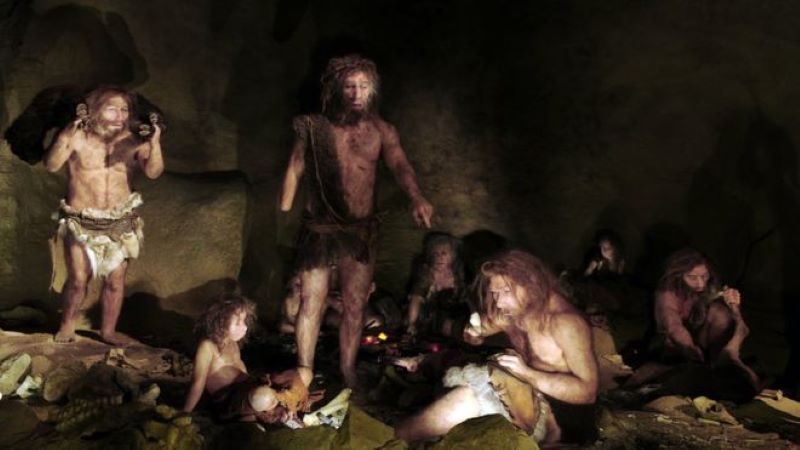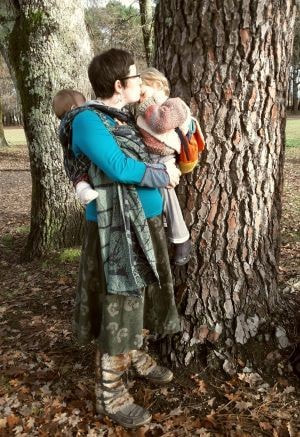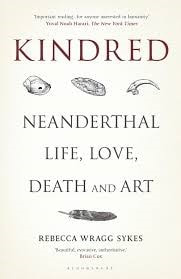 A rendering of Neanderthals in a cave. Image credit: Tyler B. Tretsven. From: sci-news.com A rendering of Neanderthals in a cave. Image credit: Tyler B. Tretsven. From: sci-news.com Doctor, Doctor! I have great news! That malevolent earworm has subsided. I don't have to worry 24/7 about what he is stealing, what he is breaking. I have more time for other things -- like reading. * * * We can’t get enough of our long-lost neighbors. At least, I can’t. And the growing study of Neanderthals tells me this is a collective curiosity. With a flash of recognition, we see something of ourselves in them, as they tried to survive, As the earth thaws, as our science grows, we are learning more about the people who co-existed with “us” until about 40,000 years ago. Many “humans” stare at renderings of what Neanderthals may have looked like, based on recent findings of Neanderthal bones. Sometimes the adults are pictured holding a child, just like us. The latest source of my fascination is a book, “Kindred: Neanderthal Life, Love, Death and Art,” by Rebecca Wragg Sykes, published by Bloomsburg Sigma in November, and already greedily devoured by this reader.  The author and daughters, mid-2017 The author and daughters, mid-2017 The more I read, the more my admiration grows for Neanderthals, named for one of the early discoveries in the Neander Valley near Dusseldorf, Germany. Sykes describes in great detail how they chiseled tools out of rocks, knowing what they were doing, and how they made spears and arrows to hunt the fat-laden animals that would sustain them. Sykes details how these Neanderthals migrated with the seasons and shifts in climate, how they seemed to know, to remember, where the water was, where hiding places were, where they could cook, congregate, tend to their tools and garments, care for children, and sometimes bury their dead. Other people existed in the same regions – Homo sapiens up from Africa, Denisovans across Asia, both groups encountering Neanderthals as they made their last stand in southern Europe. Sykes saves the best part for the end – the mystery that has made Neanderthals an appealing subject. Married, with two young daughters, living in mid-Wales, Sykes helps the reader understand a people that got squeezed out, many perishing in the caves and crannies of Spain and France.  As we unworthy survivors pollute the only world we have, Sykes points out one benefit of our pollution: Soon we will discover more Neanderthal bodies emerging from the melting permafrost. Twelve hours after I read her prophesy, I found a recent story about an ancient baby wolf that has been found intact in the Yukon. https://www.nytimes.com/2020/12/21/science/wolf-puppy-mummy.html Before we expire, we may understand more about our complex ancestors as they roamed the earth, at least three separate species, standing on two legs, encountering each other on their search for food and shelter and, when they got up close, sometimes doing what came naturally. I don’t think I am giving away too much to reveal Sykes’ final words, which confirmed to me the current aura of these people who were “just like us.” Sykes’ penultimate chapter ends: “Neanderthal. Human. Kindred.” * * * (my previous post on Neanderthals) https://www.georgevecsey.com/home/lets-have-some-respect-for-neanderthals (The recent NYT review of Sykes’ book) https://www.nytimes.com/2020/11/07/books/review/kindred-neanderthals-rebecca-wragg-sykes.html?searchResultPosition=2
Ina Lee Selden
1/24/2021 07:42:50 pm
George: Does this mean that the people I consider neanderthals
Geo
1/24/2021 07:50:30 pm
Hi, Ina: You should ask the ticked-off, squash-playing traveler in the airport in the old Geico commercial. (see my link at bottom) He got mad at the concept of "Caveman." Maybe there is even an association of people with Neanderthal DNA, with paid lobbyist and all. I wouldn't mess with them. We have two friends, both women, both accomplished modern types, who have been told they have the DNA, I told them I was jealous. Best, G
bruce
1/25/2021 01:47:47 am
george,
George
1/25/2021 08:32:38 am
I would never denigrate Neanderthals by linking them with the outlaws who stormed the Capitol. Neanderthals, according to the author, were not as gratuitously violent as the old stereotype suggests. As for Viking ancestry, I don't know about DNA per se, but surely ancient Scandinavians scattered southward, leaving names and places and genes. (My wife's provable ancestry goes back to William the Conqueror who is traced northward to Rollo....Her maternal uncle could make little fishing boats in his large basement and take them out on the Kennebec River and ponds in Maine.) Be kind to the Neanderthals. GV
bruce
1/25/2021 08:54:30 am
george, 1/25/2021 10:46:45 am
One learns from studying history how talented our ancestors were regardless of how far back you go.
George Vecsey
1/26/2021 09:10:54 am
Alan: thanks for the prodding. I read 50 pages or so of "Sapiens" and for some reason never got back....I have it right here and will re-commence.
ED MARTIN
1/25/2021 02:38:38 pm
The problem with this kind of column is two-fold: First, Pence tells me the world is only 6000 years old, so all this talk is fake news.
George Vecsey
1/25/2021 03:47:43 pm
Michelle Goldberg called him a "callous schmuck" a few months ago.
Altenir Silva
1/25/2021 05:33:45 pm
Dear George: Interesting article about our past. I think we have a lot to learn from Neanderthals and other civilizations, like the Aztecs, Mayans and Incas. Comments are closed.
|
Categories
All
|









